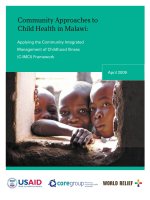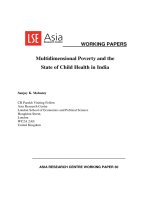Child abuse in vietnam
Bạn đang xem bản rút gọn của tài liệu. Xem và tải ngay bản đầy đủ của tài liệu tại đây (15.47 MB, 43 trang )
Child Abuse
The Forensic Investigation
Michael Ward, MD
Chief Medical Examiner
Greenville, South Carolina
Child Abuse
• The physical, sexual, or mental injury,
exploitation or negligent treatment of a
child under the age of 18 years, by a person
responsible for the child’s welfare.
• Six patterns of abuse
-Physical abuse
-Sexual abuse
-Intentional drugging -Medical neglect
-Nutritional deprivation
-Emotional abuse
Child Abuse
• In the United States, 1 – 2% of children
reported to be abused.
• Incidence is 700 to 1,200 per million.
• 2,000 – 4,000 deaths per year.
• Age-range:
– One-third less than one year.
– One-third 1 – 6 years
– One-third 6 – 18 years
Child Abuse
• The Abuser
–
–
–
–
Parents (father more often than mother)
Other caregivers (boyfriends, babysitters)
Physically or emotionally exhausted
Alcohol or other drugs often involved
Injuries in Child Abuse
• Blunt injuries to any body surface most
common injury.
• Head injury most common fatal injury.
• Blunt trauma to abdomen also common.
• Skeletal injuries, burns, drownings are also
seen.
General characteristics of child
abuse
•
•
•
•
•
Injury unexplained by the history given.
Delay in seeking care.
Changing, evolving, or inconsistent history.
Inappropriate affect of caregivers.
“Trigger event” precipitating loss of control
of caregivers.
Non-accidental Head Injuries
• Formerly known as “Shaken Baby
Syndrome”
• Common findings include:
–
–
–
–
Subdural hemorrhage
Retinal hemorrhage
Diffuse axonal injury
May or may not have external injuries
Non-accidental Head Injuries
• The term Shaken Baby Syndrome has lost
popularity in the United States and Great Britain.
Many investigators disagree on the biomechanics
of shaking infants, and many feel these injuries do
not happen in this way. For this reason, many
forensic pathologists have dropped the diagnosis
of Shaken Baby Syndrome for the more general
description of Non-accidental Head Injuries.
Subdural Hemorrhages
• Results from tearing of bridging veins
extending from arachnoid to dura.
• Hemorrhages are generally small and are
markers of trauma.
• Not a space occupying hemorrhage.
• May be exceptionally small, or associated
with focal sub-arachnoid hemorrhage.
Subdural hemorrhage
Head injuries may or may not be present
Retinal Hemorrhage
• Variably sized and located hemorrhages
within, behind, or on top of the retina.
• At the posterior pole of the eye, tend to be
flame shaped hemorrhages.
• Laterally, may be dot/blot hemorrhages or
retinal tears.
Differential Diagnosis of
Retinal Hemorrhage
• Birth Trauma-seen in 1/3 of vaginally
delivered babies, resolve quickly (weeks).
• Increased intracranial pressure-arteriovenous mismatch.
• Shaken baby syndrome
• Head trauma-Tearson syndrome, severe
head injuries, acceleration-deceleration
injuries.
Differential Diagnosis of
Retinal Hemorrhage
•
•
•
•
•
•
Sepsis
Coagulopathy
Subacute bacterial endocarditis
Sickle cell disease
Acute leukemias
Congenital infections
Subdural hemorrhage
Subdural hemorrhage:
Cross sections of optic
nerves
Subdural hemorrhage, optic nerve









